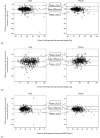Validity of self-reported weight and height of adolescents, its impact on classification into BMI-categories and the association with weighing behaviour
- PMID: 20054463
- PMCID: PMC2790101
- DOI: 10.3390/ijerph6102696
Validity of self-reported weight and height of adolescents, its impact on classification into BMI-categories and the association with weighing behaviour
Abstract
This paper investigated the validity of self-reported height and weight of adolescents for the diagnosis of underweight, overweight and obesity and the influence of weighing behaviour on the accuracy. A total of 982 adolescents reported their height, weight, weighing behaviour and eating patterns in a questionnaire. Afterwards, their height and weight were measured and their Body Mass Index (BMI)-categories were determined using age- and gender-specific BMI cut-off points. Both girls and boys underreported their weight, whilst height was overestimated by girls and underestimated by boys. Cohen's d indicated that these misreportings were in fact trivial. The prevalence of underweight was overestimated when using the self-reported BMI for classification, whilst the prevalence of overweight and obesity was underestimated. Gender and educational level influenced the accuracy of the adolescents' self-reported BMI. Weighing behaviour only positively influenced the accuracy of the self-reported weight and not height or BMI. In summary, adolescents' self-reported weight and height cannot replace measured values to determine their BMI-category, and thus the latter are highly recommended when investigating underweight, overweight and obesity in adolescents.
Keywords: adolescents; body mass index; height; validity; weighing behaviour; weight.
Figures
Similar articles
-
Web-based self-reported height, weight, and body mass index among Swedish adolescents: a validation study.J Med Internet Res. 2015 Mar 18;17(3):e73. doi: 10.2196/jmir.3947. J Med Internet Res. 2015. PMID: 25791395 Free PMC article.
-
Measuring the bias, precision, accuracy, and validity of self-reported height and weight in assessing overweight and obesity status among adolescents using a surveillance system.Int J Behav Nutr Phys Act. 2015 Jul 27;12 Suppl 1(Suppl 1):S2. doi: 10.1186/1479-5868-12-S1-S2. Epub 2015 Jul 27. Int J Behav Nutr Phys Act. 2015. PMID: 26222612 Free PMC article.
-
Validity of Self-Reports of Height and Weight among the General Adult Population in Japan: Findings from National Household Surveys, 1986.PLoS One. 2016 Feb 10;11(2):e0148297. doi: 10.1371/journal.pone.0148297. eCollection 2016. PLoS One. 2016. PMID: 26862762 Free PMC article.
-
[How accurate are self-reported anthropometrics among the Japanese? A scoping review].Nihon Koshu Eisei Zasshi. 2023 Dec 21;70(12):817-827. doi: 10.11236/jph.23-020. Epub 2023 Sep 5. Nihon Koshu Eisei Zasshi. 2023. PMID: 37673596 Japanese.
-
Reliability of Self-Reported Height and Weight in Children: A School-Based Cross-Sectional Study and a Review.Nutrients. 2022 Dec 23;15(1):75. doi: 10.3390/nu15010075. Nutrients. 2022. PMID: 36615731 Free PMC article. Review.
Cited by
-
Validity of self-reported height and weight among adolescents: the importance of reporting capability.BMC Med Res Methodol. 2013 Jun 27;13:85. doi: 10.1186/1471-2288-13-85. BMC Med Res Methodol. 2013. PMID: 23805955 Free PMC article.
-
Accuracy of Self-Reported Height, Weight, and BMI Over Time in Emerging Adults.Am J Prev Med. 2019 Jun;56(6):860-868. doi: 10.1016/j.amepre.2019.01.004. Epub 2019 Apr 17. Am J Prev Med. 2019. PMID: 31003807 Free PMC article.
-
Psychopathological Symptoms and Well-Being in Overweight and Underweight Adolescents: A Network Analysis.Nutrients. 2021 Nov 16;13(11):4096. doi: 10.3390/nu13114096. Nutrients. 2021. PMID: 34836351 Free PMC article.
-
Validity and predictors of BMI derived from self-reported height and weight among 11- to 17-year-old German adolescents from the KiGGS study.BMC Res Notes. 2011 Oct 17;4:414. doi: 10.1186/1756-0500-4-414. BMC Res Notes. 2011. PMID: 22005143 Free PMC article.
-
Assessment of Dietary Intake and Eating Attitudes in Recreational and Competitive Adolescent Rock Climbers: A Pilot Study.Front Nutr. 2019 May 10;6:64. doi: 10.3389/fnut.2019.00064. eCollection 2019. Front Nutr. 2019. PMID: 31134207 Free PMC article.
References
-
- Lobstein T, Baur L, Uauy R. Obesity in children and young people: a crisis in public health. Obes. Rev. 2004;5:4–85. - PubMed
-
- Nieto-Garcia FJ, Bush TL, Keyl PM. Body mass definitions of obesity: sensitivity and specificity using self-reported weight and height. Epidemiology. 1990;1:146–152. - PubMed
-
- Spencer EA, Appleby PN, Davey GK, Key TJ. Validity of self-reported height and weight in 4808 EPIC-Oxford participants. Public Health Nutr. 2002;5:561–565. - PubMed
-
- Niedhammer I, Bugel I, Bonenfant S, Goldberg M, Leclerc A. Validity of self-reported weight and height in the French GAZEL cohort. Int. J. Obes. 2000;24:1111–1118. - PubMed
-
- Young People’s Health—A Challenge for Society. World Health Organization; Geneva, Switzerland: 1986. World Health Organization Study Group on Young People and “Health for All by the Year 2000”. - PubMed
Publication types
MeSH terms
LinkOut - more resources
Full Text Sources
Medical


